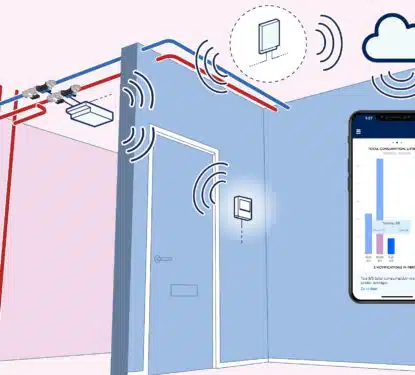This presentation discusses our latest research on IoT connectivity in commercial buildings, projecting growth from approximately 2 billion connected devices in 2024 to 4 billion by 2030.
Our analysis covers retail, offices, hotels, warehouses, and data centers, examining connectivity types, implementation frameworks, emerging technologies, and security considerations.
Commercial Building IoT Technology Stack
Our research identifies 5 interconnected layers that form the foundation of commercial building IoT systems:
- Sensing Layer: The physical-digital interface where sensors capture real-world data on occupancy, environmental conditions, and equipment status.
- Networking & Connectivity: Data transmission infrastructure using various short and long-range wireless options with different bandwidth, power, and range trade-offs.
- Gateways & Edge Processing: Intermediate hardware that aggregates sensor data, translates protocols, performs local analytics, enhances security, and increasingly provides edge computing capabilities.
- Data Storage & Processing: The analytical backbone that transforms raw data into structured insights using cloud or hybrid approaches.
- Application Layer: User-facing systems delivering actionable intelligence through dashboards, controls, and automation for energy management, security, and space utilization.
Cross-cutting concerns include security, privacy, management, governance, and interoperability.
Mapping the Building Internet of Things
Our “tube map” visualization represents the complexity of building technology systems and illustrates how traditionally siloed systems are increasingly connected in a cohesive data-driven ecosystem. The aspirational definition of building IoT is a network connecting these siloed systems to operate without human intervention.
Key elements depicted include:
- Various technology systems and their interconnections.
- Data standards and communication protocols.
- Enterprise connections and data flows.
Key Market Trends
Several significant trends are reshaping the commercial building IoT landscape:
- Intelligence Migration to the Edge: Advanced IoT gateways now provide substantial compute power at the edge, with some capable of running smaller language models for real-time decision-making without cloud dependency.
- Energy Optimization: Real-world implementations show significant energy savings, with one case study demonstrating 16% HVAC energy reduction over 11 months.
- Horizontal Data Integration: Building owners are increasingly focused on unifying and analyzing data across systems.
- Grid Participation: Buildings are evolving from passive energy consumers to active grid participants.
- AI Integration: Growing implementation across systems, particularly for predictive maintenance and optimization.
AI Impact on Commercial Buildings
Artificial intelligence is transforming building operations by:
- Enabling evolution from rules-based automation to autonomous capability.
- Enhancing predictive analytics and self-optimization.
- Reducing latency through edge processing.
- Improving privacy by keeping data on-premise.
- Increasing responsiveness with less reliance on cloud connections.
However, significant challenges remain:
- Data quality issues.
- Cybersecurity concerns.
- Organizational AI readiness and knowledge gaps.
- Limitations in building-specific data for AI model training.
While the commercial building IoT market has evolved significantly over the past decade, we’re still working toward the fully autonomous, interconnected vision. Many existing systems provide intelligence but don’t yet meet the aspirational definition of seamless integration and autonomous control.
Our upcoming research (April release) will focus on integration platforms, market valuation, the competitive landscape, and emerging functionality from key vendors.



